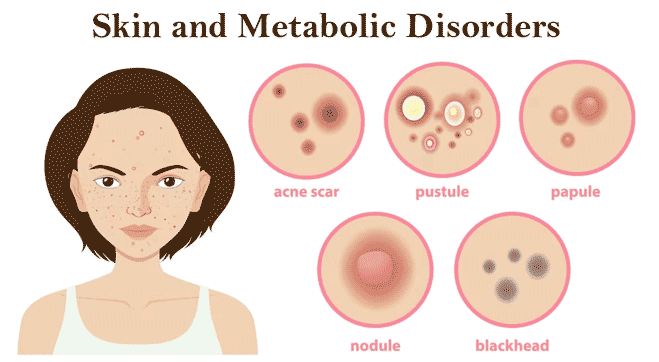What is Metabolic Syndrome?
The skin is a major organ of the human body and is exposed to various environmental
changes. However, it also offers a window to presume what is going on inside the body.
Changes in the skin may signal a more serious health problem, frequently serving as an
indicator for underlying internal disorders collectively known as Metabolic Syndrome (Mets).
What are the factors of metabolic syndrome?
Several internal disorders present skin issues which may precede and occur concurrently with
the internal conditions. There are studies about relationship of the most common skin
manifestations of Metabolic Syndrome (e.g., diabetes, obesity, Hypertension, hyperlipidemia, inflammatory
bowel disease, lupus erythematosus, systemic sclerosis, and tumors). However, the surveys
regarding the relationship between metabolic alterations such as Insulin
Resistance (IR) and
dermatologic (skin) conditions are still scant. These indicators facilitate an early diagnosis in
order to prevent the long-term consequences of Metabolic Syndrome.
How is Skin disorders linked to Metabolic Syndrome?
Any dysregulation in metabolism can lead to skin disorders and vice-versa. Likewise, obese
patients are prone to rashes in body folds (intertrigo) due to sweating, occlusions, rubbing
of skin surfaces together and inverse psoriasis. Psoriasis is often associated with other serious
internal health
conditions such as hypertension or high blood pressure. Adipose tissue
(fat tissue) increases the production of androgens
(male hormones
) in obese women making them more prone to polycystic
ovarian syndrome. High blood glucose levels (Diabetes
)
may result in poor wound healing and excess insulin
lead the skin cells to grow abnormally. Dyslipidemia is another condition that causes
development of fatty growths underneath the skin.
What are the Skin Signs of Metabolic Syndrome?
Acne Acne vulgaris is a multifactorial condition caused by endocrine abnormalities. It represents the most common skin disorders affecting about 85% of adolescents. The high prevalence cannot be only explained by the predominance of genetic factors but by the diet that overstimulates the metabolism nutrients and growth factors. One of the possible mechanism that explains acne in Metabolic Syndrome is a nutrient-activated mTORC1 signal that plays an important role in causing acne. Increased mTORCi signaling is a characteristic feature of IR, obesity, cancer , and neurodegenerative diseases.
Psoriasis Among the various skin conditions investigated at present, psoriasis holds a great interest in relation to Metabolic Syndrome. Psoriasis is a chronic inflammatory disease, affecting 1 to 4% of the general population. It is considered as a multisystem disorder, rather than a skin disease alone. Its prevalence is about 15-25%. A plausible hypothesis states that psoriasis influences Metabolic Syndrome and arterial stiffness due to the various inflammatory markers [Interferon-Y, Interleukin (IL)-2, IL-12, and Tumor Necrosis Factor (TNF)-a] circulating in the blood, the so-called ‘psoriatic march.’ It also states that psoriasis is a chronic systemic inflammatory disease that results in IR by altering insulin receptors
Hidradenitis Suppurativa A disorder that affects body parts such as the axillae and groin. Among other there was a higher incidence of diabetes, obesity, dyslipidemia and hypertension in people affected with this disorder
Alopecia Androgenic alopecia is related to Metabolic Syndrome and its early onset could be an independent factor pointing Metabolic Syndrome. A female pattern hair loss especially in people with hypertension and obesity makes it evident. The increase in free testosterone during IR is a contributing factor. Oxidative stress mechanism in addition accelerates the aging Mass Indices (BMI). Women with process, which further deteriorates squamous cell carcinoma/non with the advancing age.
What are Other Inflammatory and Auto immune skin diseases?
Lichen Planus
Patients with this condition are at increased risk for
Cardiovascular Diseases as they
develop dyslipidemia more frequently
Systemic Lupus Erythematosus (SLE) Patients with SLE produce antibodies that attack insulin receptors causing hypoglycemia.
Atopic Dermatitis- Atopic dermatitis is positively related to Metabolic Syndrome adding to the panel of inflammatory skin conditions with systemic involvement.
Seborrheic Dermatitis Very common skin condition affecting mainly scalp and areas of the face like the eyebrows and nasolabial folds appears to be in recent studies as a predictive factor for Metabolic Syndrome.
Skin Cancer The study of the relationship between Metabolic Syndrome and skin cancer suggests there is increased blood pressure, increased women with malignant melanoma (cancer) Also, men with malignant melanoma tend to have higher Body
Mass Indices (BMI). Women with squamous cell carcinoma/non melanoma skin cancer have a tendency towards increased glucose
Full Body Checkup | Price Rs. 750 onwards
What diagnostic test is used to diagnose a skin disorder?
A variety of skin tests can be performed for diagnosing skin
disorders, bacterial, viral, or fungal skin infections, and other problems
affecting the skin. They aid in
determining the difference between
malignant (cancerous) and benign
(non-cancerous) growths
The most common skin tests are:
Patch Testing: Used to diagnose Metabolic Syndrome adding to the panel of skin allergies
Skin Biopsy : Diagnose skin cancer or benign skin disorders
Culture: Identify the microrganism (bacteria, fungus, or virus) that is causing an infection
Most of the time, prevention and precaution can prove to be the best way to manage skin problems. Reporting sores, wounds, rashes, or other problems with the skin to the doctor or dermatologist can aid in healing. Sometimes an itch, pain, or discomfort is the first sign that a skin condition is beginning








